| What is it? |
-
Carpal tunnel syndrome is the effect of pressure on the median nerve,
one of the main nerves of the hand. It can result in a variety of problems,
including pain, tingling, numbness, swelling, weakness or clumsiness of
the thumb, index, middle and ring fingers.
|
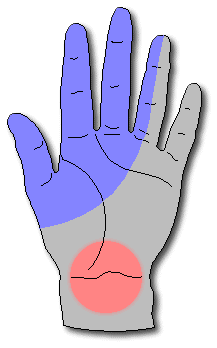
| What caused it? |
-
Carpal tunnel syndrome develops in people who have a tendency toward swelling
or inflammation in their hands.
-
Like a telephone cable, the median nerve is a connection between the fingers
and the spinal cord. It passes a through a protective conduit (tunnel)
deep in the wrist (carpus), along with the nine tendons which bend the
fingers. The nerve and each of the tendons are each nearly as wide as a
pencil. The tunnel is only a little over an inch wide - just big enough
to hold the nerve and tendons. When the tendons are irritated, the lining
around the tendons (synovium) swells up and puts pressure on the nerve.
This pressure cuts off the blood supply to the nerve.
-
Tendon swelling (tendinitis) results from a person's own tendency to collect
fluid around their tendons and joints. This may be aggravated by repetitive
or strenuous activities.
-
Swelling from adjacent problems, such as trigger finger,
basal
joint arthritis, rheumatoid arthritis or effects
of a wrist fracture may aggravate or bring on carpal
tunnel syndrome.
-
Early on, symptoms occur during sleeping hours. This is because the swelling
is relieved by normal use of the hand which pumps extra fluid out of the
carpal tunnel. The fluid pressure builds up only when the hand is at rest
- especially during sleep. Bending the wrist may also increase pressure
on the nerve.
-
In more advanced cases, symptoms occur during waking hours. At this
stage, scar tissue may form around the nerve from repeated episodes of
pressure. Nerve damage is suspected when any symptoms occur regularly during
the day.
|
| What can you do to help? |
-
As many as two out of three people with mild carpal tunnel syndrome will
have some improvement with Stretching Exercises
designed to relieve pressure within the carpal tunnel as outlined here.
-
"Over the counter" non-steroidal anti-inflammatory medication (NSAID),
such as aspirin, ibuprofen, naprosyn, or ketoprofen. Check with your pharmacist
regarding possible side effects and drug interactions.
-
Take Vitamin B6 100 mg daily (not more) - controversial, but can't hurt,
and might help. If you are pregnant or receiving vitamin therapy already,
first check with your doctor.
-
A splint or brace which supports the wrist, to use while sleeping.
-
Wait and watch.
|
| What can a therapist do to help? |
-
Provide a hand splints to support the wrist.
-
Help identify aggravating activities and suggest alternative postures.
|
| What can a doctor do to help? |
-
Confirm that this actually is the problem. This may require special nerve
tests done by a neurologist.
-
Prescribe stronger NSAID medication or cortisone-type medication.
-
Prescribe hand therapy and/or a custom prescription splint.
-
The most effective treatment without surgery is a cortisone shot into the
carpal tunnel. Depending on several factors, these measures can provide
provide long-term relief in 5 to 60 per cent of patients. Conservative
treatment is usually not recommended for patients who have evidence of
nerve damage.
-
Surgery for carpal tunnel syndrome is intended to provide more space for
the nerve and tendons, so that swelling will not put dangerous amounts
of pressure on the nerve. It is usually done through an incision on the
palm or the front of the wrist.
|
 |
| An incision is made to open the carpal tunnel. |
|
|
|
| It heals with more space inside for the nerve and tendons - like letting
out a pair of pants. |
|
-
Carpal tunnel syndrome associated with other medical conditions, such as
rheumatoid
arthritis, may require a more extensive cleaning out of the tissue
around the tendons, referred to as a synovectomy.
| There are many different techniques used for the surgery - whether
it involves a cut in the palm, the wrist, smaller or longer cuts or different
instruments, the one thing in common is that the thick layer of ligament
in front of the nerve is cut. |
|
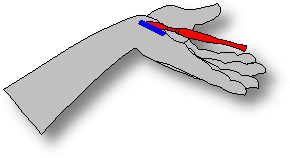
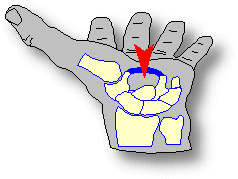
|
| After surgery, the healing edges of the ligament beneath the skin are
usually tender for at least four to six weeks after the procedure. Temporary
tenderness on each side of the palm where the ligament is attached to the
bones on each side of the palm these bones is common after surgery and
is called "pillar pain". This generally resolves gradually. Hand therapy
is often helpful during recovery. |
|
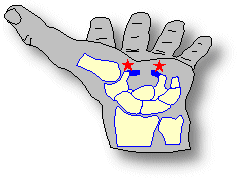
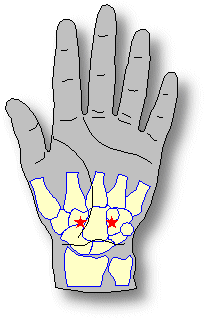
|
| How successful is treatment? |
-
Swelling, stiffness, aches and pains in the hand may well be due to other
problems, and may persist to some extent following any form of treatment.
-
Nerve damage existing before treatment may lead to incomplete recovery.
-
With this in mind, the great majority of patients are improved with appropriate
treatment. Most reports indicate that if carpal tunnel syndrome is the
only problem, over 95% of patients have a satisfactory outcome from surgery.
|
| What happens if you have no treatment? |
-
It depends most importantly on whether or not the problem actually is
carpal tunnel syndrome and whether or not there are other medical
conditions contributing to the overall picture.
-
Mild carpal tunnel syndrome can improve without treatment in as many as
one in three people.
-
The chances of getting better without surgery are less
when
-
both hands are involved.
-
the longer the problem has been going on.
-
the older the person is.
-
the more severe the symptoms of numbness and tingling are.
-
The longer the nerve is irritated, the longer numbness or tingling are
constant, the harder it is to have a full recovery - even with surgery.
If the problem is severe, however, surgery is a reasonable step to prevent
further nerve damage even if full recovery can not be guaranteed.
|
|





